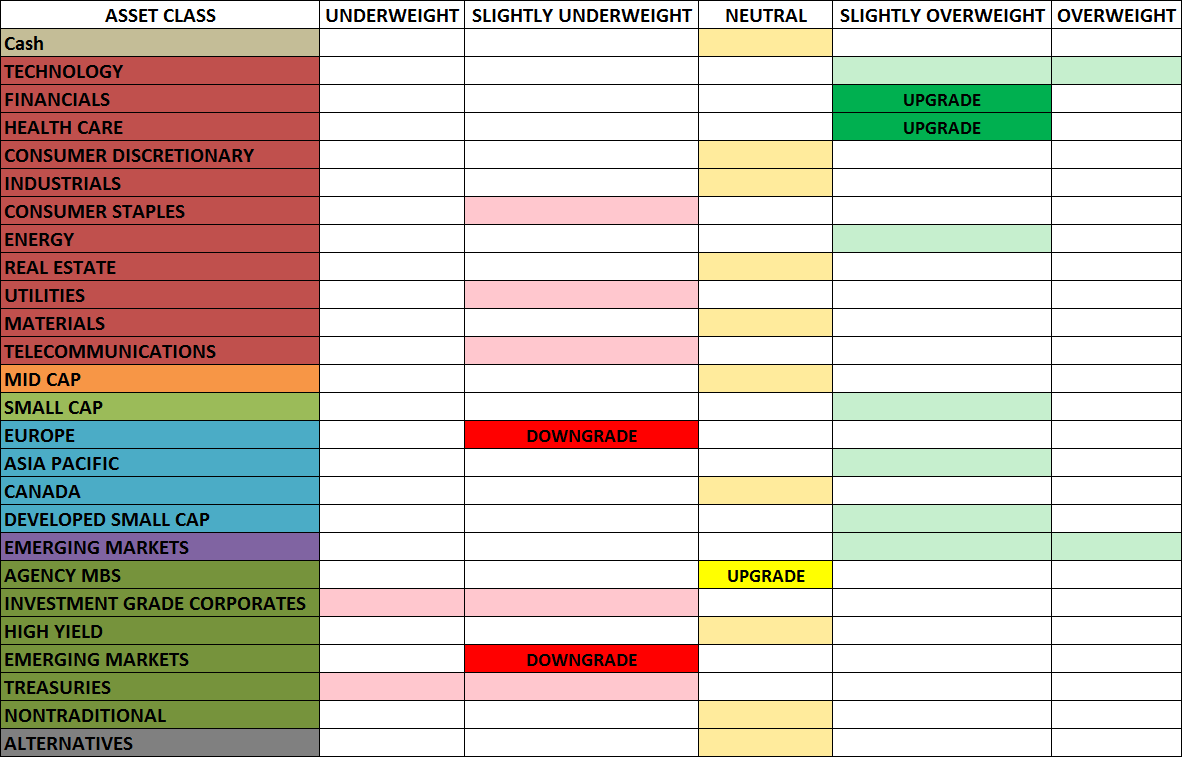Bulls and bears can both point to different sets of data to make their case on the markets. Bulls can point to continued strength in the Leading-Coincident Indicator which shows no sign of a recession and a flattening, but not yet inverted, yield curve which has historically been the best time to be invested. We also just had the strongest GDP number (4.2%) since Q3 2014! Bears can look at high debt levels continuing to pile up in our Federal government as well as in corporate debt, where the next potential bubble may be hiding. The good news on the debt level is that households, the financial sector, and state/local governments continue to show low and falling debt levels. More bad news comes from overseas where trade tensions, hawkish US monetary rhetoric, and strong oil prices have put real pressure on Emerging Markets.
The S&P posted its best quarter since 2013 with a 7.2% gain amid low volatility and countering what has historically been a tough part of the calendar. The U.S., Canada, and Mexico finally agreed on terms for a revamp of NAFTA that has helped alleviate trade concerns with our closest trade partners. Unfortunately, the U.S. and China are further from a deal with the US potentially slapping an additional 25% on $267 billion of Chinese imports. With China importing less of our goods their potential recourse would be to sell US treasuries (flooding the market and causing our rates to spike), block mergers and acquisitions by U.S. companies worldwide, or the more likely scenario of harassing U.S. companies that do business in China. In the short-term, it appears that China will wait until after the U.S. midterms to see how strong President Trump’s hand will be at that time.
The Fed hiked rates another 25bps (0.25%) in September and the markets are pricing in 3 more hikes (1 in December and 2 next year) before the Fed could potentially take a break. Yields continue to push higher and are closing in on a major resistance level that has held since the early 1980s. Midterm elections are approaching in November and the talking heads are leaning towards a split Congress with Democrats taking the house and the Republicans keeping their slim Senate majority. It is important not to mix politics with investing as historically markets have performed the best during periods of split government.
KEY THEMES
Seasonality kicks into high gear as the end-of-the-year tends to be the strongest performing part of the calendar for markets.
We have shortened duration within fixed income as investors can get better yield on short-duration instruments than the S&P 500’s dividend yield without having to go far out on the yield curve.
International equities have become historically cheap and still have favorable long term growth prospects.
KEY RISKS
2019 will be a crucial year as extensive fiscal stimulus helped juice the economy in 2018 but with fears of overheating it will be important to see if growth can be sustained.
Trade tensions and other geopolitical issues can continue to hinder growth prospects.
The U.S. Fed will have to begin to balance their worries on overheating/inflation with that of restricting growth in the U.S. and the pass-on effect it has on international monetary policy and growth.
KEY CHANGES
As mentioned above, I have shortened duration in Fixed Income as that part of the curve tends to outperform when the curve is flattening.
Upgrades
- Financials – further rate hikes as well as recent under performance make Financials attractive
- Health Care – tends to outperform well during late cycle/recession as well as having growth (biotechnology/health care equipment) and value (big pharma) characteristics
- Agency Mortgage Backed Securities (MBS) – moving up in quality in Fixed Income as household debt levels are constructive and higher rates lead to less prepayment risk
Downgrades
- Europe – short-term tactical downgrade until lingering issues surrounding Italy’s budget plans and Brexit are resolved
- Emerging Market debt – reduce some of our EM exposure (still overweight equities) due to sensitivities towards US monetary policy and a stronger dollar
Written by: Antonio Belmonte, CFA, Chief Investment Officer
These are the opinions of Antonio Belmonte and not necessarily those of Cambridge, are for information purposes only, and should not be construed or acted upon as individualized investment advice. Investing involves risk. Depending on the types of investments, there may be varying degrees of risk. Investors should be prepared to bear loss, including total loss of principal. The strategies discussed herein are not designed based on the individual needs of any one specific client or investor. In other words, it is not a customized strategy designed on the specific financial circumstances of the client. However, prior to opening an account, Cambridge will consult with you to determine if your financial objectives are appropriate for investing in the model. You are also provided the opportunity to place reasonable restrictions on the securities held in your account.

